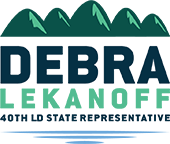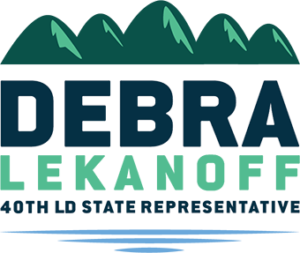Uplifting Our Community on Fantastic Friday
Dear Friends,
Last week, we emphasized the critical importance of being informed about the upcoming election and its potential consequences. The presidential election will significantly influence how state and local governments implement federal policies. Our state policies must be designed to protect our progress and ensure equal protection for all. Now, more than ever, we need to come together and foster clear collaboration across governing bodies. It’s essential to find pathways to unify our decisions and actions.
With this in mind, it is so important that we vote. Ballots are in the mail, so check your mailboxes and be sure to vote early!
As I continue to engage with local governments, I deeply respect their efforts to serve their communities. These governing bodies are dedicated to forming partnerships and implementing policies that acknowledge the interconnectedness of families, workforces, food systems, and economies.
Local governments are truly the “boots on the ground,” exemplifying the importance of local control and decision-making. They are foundational to addressing the issues, challenges, and opportunities that impact our daily lives. While political battles at the federal level affect our economies, inflation rates, gas prices, food costs, housing, and retirement investments, it is the local programs and services that directly touch our kitchen tables, providing food for children and families and ensuring elders receive the care they need.
An exemplary initiative is the Skagit North Star Initiative. North Star is a program consisting of public and private partners that address critical unmet needs in our communities. This program tackles mental, behavioral, and substance disorders, affordable housing and homelessness, elder services, support for the disabled, and food provision. The Skagit North Star program stretches across the districts of the 40th, 39th, and 10th, and engages areas as far-reaching as the 1st and 42nd. This initiative exemplifies how local governments can come together to build future plans for today and generations to come.
Local governments understand the immediate needs and challenges of their communities. Their efforts in building partnerships and fostering relationships are crucial for the successful implementation of policies that protect and uplift everyone. They are setting an example of effective governance by working tirelessly to bring together diverse stakeholders. Their collaborative approach ensures that everyone benefits from the programs and services established.
As we look to the future, it is essential to recognize the significance of the work being done by local governments. They are not only implementing policies but also shaping the future through thoughtful and inclusive decision-making. By fostering collaboration across all governing bodies, we can ensure our communities’ needs are met and our progress is protected.
Next week, we will delve deeper into how these governing bodies are collaborating to take care of everyone in the district and across the state.
Keep reading for more on this Fantastic Friday.
Rep. Debra Lekanoff
Protect the Whatcom County Children’s Initiative
The County Council of Whatcom County is currently facing a critical legal challenge regarding the validity of a group’s effort to repeal a countywide child care tax known as Proposition 5, also referred to as the Healthy Children’s Fund. This challenge comes as the council nears the deadline to place the repeal measure on the ballot for the upcoming November election, with nearly $100 million in property taxes hanging in the balance over a 10-year period. For Whatcom County Health and Community Services, the Healthy Children’s Fund additional 10 million revenue contributions match the state and local revenue investments.
The administration of the Healthy Children’s Fund in Whatcom County plays a crucial role in supporting young children and their families through a voter-approved initiative. The core concept behind the Healthy Children’s Fund is to invest in the well-being of our youngest community members and their families in order to yield lasting benefits for the entire Whatcom County community.
By focusing on early support and resources for children and families, the Healthy Children’s Fund aims to lay a solid foundation that will positively impact the development and overall welfare of these individuals in the long term. This initiative recognizes the importance of nurturing and empowering youth during their formative years, acknowledging the significant influence this can have on their future well-being and success.
Through the implementation of the Healthy Children’s Fund, Whatcom County is not only prioritizing the needs of its youngest residents but also embracing a vision of community-wide growth and prosperity. By investing in early childhood development and family support services, the county is fostering a culture of care, resilience, and opportunity that extends far beyond individual households.
The fundamental principle underlying the Healthy Children’s Fund initiative is the belief that by supporting children and families at the early stages of life, the community as a whole stands to benefit from a healthier, more vibrant, and prosperous future. This overarching vision highlights the interconnectedness of individual well-being and community vitality, emphasizing the pivotal role that investing in youth and family support plays in shaping a thriving and resilient Whatcom County for generations to come

Today the Healthy Children’s Fund is a critical issue for Whatcom County Council and their citizens. The Whatcom County Council’s decision to ask a Superior Court judge to answer questions about the validity of a group’s effort to repeal a countywide child care tax puts the council in new territory as it faces a fast-approaching deadline. In a split decision, the council voted to seek judicial clarification on this matter, marking a novel situation for many members and they highlighted the urgency due to the approaching August 6 deadline set by the Auditor for ballot placement.
The initiative to repeal Proposition 5, spearheaded by Washingtonians for a Sound Economy, garnered significant public attention following its submission of signatures for approval. This move sparked a detailed examination of the county charter’s provisions surrounding the differentiation between initiatives and referendums, shedding light on the intricate legal requirements for each process.
With the legal dispute now transitioning to the judicial sphere, the council has embarked on the task of retaining outside legal counsel, a move that incurs significant costs estimated at $100,000. As the legal proceedings unfold, the timeline remains uncertain, fueling concerns about timely resolution given the impending election.
Amidst these complexities, council members grapple with balancing procedural integrity and public trust, navigating the fine line between upholding due process and fostering a transparent decision-making environment. As the council prepares for the upcoming vote on placing the repeal initiative on the November ballot, the overarching goal remains to ensure a fair and informed electoral process, despite the intricate legal hurdles that lie ahead.
Olympia Comes to Whatcom County
This week, I joined the Whatcom County Department of Health and Community Services, WA State Department of Health, Office of Finance and Management, and Legislative House and Senate Health Committee Staff to learn more about the FPHS investments in Whatcom County.
FPHS stands for “Foundational Public Health Services.” It refers to essential public health services that are fundamental to protecting and improving community health. The governmental public health system, comprising the state department of health, state board of health, local health jurisdictions, sovereign tribal nations, and Indian health programs, is responsible for protecting public health across the state. FPHS are core services that this system must provide consistently and uniformly in every Washington community.
Foundational Public Health Services encompass a broad range of activities such as disease prevention, health promotion, emergency preparedness, and community health assessment in Washington State.
These services aim to address the underlying factors that influence health outcomes and contribute to overall population well-being. During our meeting with Whatcom County, staff testified about the impact of these funds in building capacity for previously underfunded yet essential community programs. They emphasized that the most significant and mutual feeling in the county and among citizens is the trust that healthcare will be provided for all.
The Whatcom County Health and Community Services Department champions public health through diverse programs, health education, and community collaborations. They prevent diseases, promote healthy behaviors, and enhance health outcomes within the community. By ensuring access to vital health services and conducting emergency preparedness, they safeguard residents during crises and emergencies. Collaborating with partners and analyzing health data enables targeted interventions, addressing health disparities and promoting equity.
The Legislature allocates FPHS funds from the State General Fund, and recommendations suggest exploring long-term and stable revenue sources. Top priority spending in Whatcom and other counties focused on several areas, with today’s discussion centering on investments in data gathering, assessment, and reporting. This information is vital for setting healthcare priorities, funding, and programs across state and local governments.
I look forward to working with Whatcom County Health and Community Services as they collaborate with San Juan County and Skagit County Health and Community Programs in implementing the FPHS Programs. I’m also eager to work with our Legislative House and Longevity Committee and fiscal committees to explore continued investment in the FPHS Program.
Celebrating Small Businesses in Skagit County!
The Economic Development Alliance of Skagit County (EDASC) has successfully concluded its first 12-week Small Business course, marking a significant milestone for aspiring entrepreneurs in the 40th Legislative District. This program, led by EDASC CEO John Sternlicht, aims to empower local individuals to pursue their entrepreneurial dreams, especially crucial during these challenging times for small businesses.
The course, supported by Department of Commerce funding, offers a comprehensive curriculum to equip participants with essential business skills. The recent appointment of Mike Fong as Director of the Department of Commerce signals a renewed focus on supporting small businesses across the 40th, 42nd, and 10th Legislative Districts.

EDASC’s collaboration with the My Own Business Institute (MOBI) at Santa Clara University has provided valuable resources to the participants. The hybrid classroom format has allowed for diverse participation from various locations within the state.
Graduates of this first cohort are now paired with advisors to guide them towards their business goals. These new entrepreneurs are set to launch various ventures, including childcare services, trucking companies, retail stores, and landscaping businesses.
The success of this program highlights the vital role of small businesses in driving economic vitality in Skagit County. With continued support from EDASC, local legislators, and the community, the future looks promising for small businesses in the region.
Wildfire and Air Quality in Washington
Amidst the serene Saturday morning in Anacortes, with the temperature already at 70 degrees, the beauty is marred by worries stemming from escalating climate change effects in western Washington. As I tend to my dahlias, preparing them for yet another scorching day, the impact of climate change is palpable in our communities. The persistent heatwaves and raging wildfires across the region, stretching from Bellingham to Chelan to Colville, are posing unprecedented challenges, prompting us to adapt and respond swiftly.
Washington’s Department of Natural Resources (DNR) has been vigilant in addressing the wildfire crisis, recognizing the urgent need for infrastructure investments and collaboration with local governments and citizens. The relentless efforts to equip and bolster wildfire fighters, along with enhanced salaries and incentives, reflect the state’s commitment to combating the escalating threats posed by climate change-induced wildfires. Despite these proactive measures, the wildfires are intensifying each year, straining resources and endangering both lives and properties.

From smoky valleys to rising insurance rates, the repercussions of these wildfires are far-reaching, impacting the health and well-being of our communities, from the youth to the elders. As the wildfire season unfolds, the state grapples with the increasing challenges posed by the blazes, with a particular focus on regions east of the Cascades. The dire situation calls for collaborative efforts and robust strategies to mitigate the risks and protect our environment from further deterioration.
Through a comprehensive legislative approach driven by leaders like DNR Commissioners Hilary Franz and Peter Goldmark, Washington is striving to enhance its firefighting capabilities and resilience against wildfires. The emphasis on policy frameworks, innovative infrastructure enhancements, and comprehensive safety training underscores the state’s commitment to safeguarding its citizens and natural resources.
For an Interactive Map of current active fires, check out the Seattle Times here.
As we brace ourselves for the impending wildfire season, characterized by dry conditions and heightened risks, it is imperative to stay informed and prepared. The interactive maps tracking active wildfires presented by publications like the Seattle Times serve as crucial resources for understanding the evolving wildfire landscape and taking necessary precautions.
In this shared journey to combat the escalating wildfire challenges, let us unite in our commitment to protect our communities, preserve our environment, and build a resilient future in the face of climate change-induced adversities. Together, we can navigate these challenges and emerge stronger, ensuring a safer and healthier future for generations to come.
The Growth Management Act in Washington
The Growth Management Act (GMA) in Washington State has been guiding smart growth and sustainable development since 1990. It concentrates development in urban growth areas, promotes efficient land use, and preserves natural habitats. The GMA focuses on creating walkable communities with diverse housing options to support affordability and community well-being.
In managing water resources, the GMA addresses quantity and quality concerns by protecting water sources from depletion and contamination. It emphasizes safeguarding water quality through practices like protecting critical areas and promoting sustainable water management strategies.
To address population growth and affordable housing shortages, potential GMA reforms may include incentivizing affordable housing within urban growth areas and enhancing climate resilience. This could involve streamlining approval processes, promoting higher density developments, and implementing energy-efficient building standards.
Integrating housing affordability and climate change considerations underscores Washington State’s commitment to sustainable development, social equity, and environmental stewardship. Reforming the GMA is essential for ensuring the state’s long-term sustainability and resilience, promoting inclusivity and prosperity for all residents.
For more information on the GMA and its impacts, interested individuals can explore:
- Washington State Growth Management Act Overview: https://app.leg.wa.gov/RCW/default.aspx?cite=36.70A
- Washington State Department of Commerce – Growth Management: https://www.commerce.wa.gov/topic/land-use/growth-management/
- Washington State Department of Ecology – Growth Management Act: https://ecology.wa.gov/Regulations-Permits/Growth-Management
- GMA Commerce Map of Districts: https://www.commerce.wa.gov/serving-communities/growth-management/periodic-update/
- Tribal Planning Coordination under the GMA: https://www.commerce.wa.gov/serving-communities/growth-management/growth-management-topics/tribal-planning-coordination-under-the-growth-management-act/
- GMA Grants for Local Government: https://www.commerce.wa.gov/serving-communities/growth-management/growth-management-grants/
- Skagit County GMA Update: https://salish-current.org/2024/07/09/public-has-its-say-in-comprehensive-planning/
- San Juan County GMA Update: https://engage.sanjuancountywa.gov/2025-comp-plan-update
- Whatcom County GMA Update: https://www.whatcomcounty.us/4373/2025-Comprehensive-Plan-Update
These resources provide comprehensive information on the GMA’s implementation, updates, and impact on various counties in Washington State.
The GMA and the San Juan Islands
During the recent review of the Water Element of the Comprehensive Plan by the San Juan County Council, Kimbal Sundberg, Chair of the Clean Water Advisory Committee (CWAC), emphasized the need for more data on managing water as a public resource. Sundberg expressed concerns over the lack of information regarding the actual water supply as the county updates its water-use policies.
The CWAC played a significant role in drafting the Water Element and will continue to implement policies aimed at safeguarding the islands’ finite groundwater resources through recommendations for code modifications and other protective measures.
The recently adopted 2036 Comprehensive Plan, which includes the Water Element among nine other sections, was approved on November 30. This plan, resulting from a thorough six-year process that began in 2016, will serve as a blueprint for growth and development strategies until 2036, involving advisory committees, the planning commission, and public engagement.

Despite a modest year-round population of around 18,200 residents in San Juan County as of 2022, with a growth rate of just over 1% annually, the islands experience a significant surge in visitors, particularly during the summer months. Balancing the needs of the local population and the impact of tourism on the islands’ resources remains a key consideration in managing and sustainably utilizing the water supply.
Water scarcity and quality have become pressing issues globally, and San Juan Island is no exception. As a popular tourist destination, the island experiences fluctuations in water demand, especially during peak seasons when the influx of visitors strains the existing water infrastructure.
The Sustainable Groundwater Management Act (SGMA) requires local agencies to manage groundwater resources sustainably, preventing overdraft and other undesirable effects. As the CWAC continues its work to protect the islands’ groundwater resources, the need for comprehensive data on water supply and usage becomes increasingly evident. Without accurate information, developing effective policies and strategies to ensure water security for both residents and visitors is challenging.

Efforts to address water management issues on San Juan Island must consider the delicate balance between environmental conservation, community needs, and sustainable development. By incorporating stakeholders’ input, leveraging scientific research, and implementing innovative technologies, the island can strive towards a resilient and equitable water future.
The challenges facing San Juan Island necessitate a collaborative approach involving both local and state-level investment in sustainable water management practices. By working together, the County and State can develop solutions that address the diverse management of groundwater, establish a comprehensive water inventory, and implement a climate change adaptation and mitigation plan.
Simultaneously, efforts must address the increasing demand for housing, which inherently leads to greater water needs. This multifaceted approach requires strategic planning to balance the Island’s development and growth with the reform of the Growth Management Act (GMA) to ensure sustainable resource management.
Furthermore, finding solutions to accommodate the tourism industry’s capacity while meeting the Island’s water requirements is crucial. By fostering innovation, engaging community stakeholders, and leveraging scientific research, San Juan Island can pave the way for inclusive and sustainable growth that meets the needs of both residents and visitors alike. I am honored to work with the community and my state legislators to address this critical crisis in the San Juan Islands.



